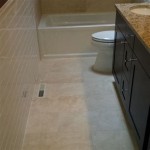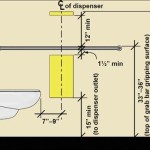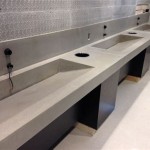What Size Plumbing Do You Need for Your Bathroom Sink?
Determining the appropriate plumbing size for a bathroom sink is a crucial step in ensuring efficient water flow and preventing potential plumbing issues such as clogs or slow drainage. Selecting the correct pipe diameter and understanding the standard plumbing connections are essential for both new installations and replacement projects. This article will provide a comprehensive guide to help understand the considerations and standards surrounding bathroom sink plumbing sizes.
In residential plumbing, the size of pipes is generally measured in nominal diameter. This refers to an approximate inner diameter and may not be the exact measurement. The materials used for plumbing, such as copper, PVC, or PEX, also influence the actual outer diameter and wall thickness of the pipes.
Standard Drain Pipe Size for Bathroom Sinks
The standard drain pipe size for most bathroom sinks is 1 1/4 inches (1.25 inches) in diameter. This dimension refers to the diameter of the drain tailpiece, the P-trap, and the drainpipe that connects to the main plumbing system. This size is considered sufficient for handling the typical water volume discharged from a bathroom sink during everyday activities such as washing hands, brushing teeth, and light grooming.
The 1 1/4 inch standard has been established based on a balance between providing adequate drainage and minimizing the space required for plumbing installations. Using a significantly smaller drainpipe could lead to frequent clogs, while an excessively large pipe would be unnecessary and potentially more costly.
It is important to note that while 1 1/4 inches is the standard for the visible drain components under the sink, the drainpipe that connects to the main plumbing stack within the wall may be a larger diameter, typically 1 1/2 inches or 2 inches. This transition to a larger pipe size allows for smoother flow as the wastewater joins the main drainage system.
When connecting the 1 1/4 inch drainpipe to a larger diameter wall drain, a reducer fitting is used to ensure a secure and leak-proof connection. This fitting gradually increases the pipe diameter, preventing turbulence in the flow.
For lavatories used in commercial settings, or those in residential settings that experience high water usage, a larger drainpipe, such as 1 1/2 inches, may be considered. However, for typical residential bathroom sinks, the 1 1/4 inch drainpipe is the established standard.
When replacing existing plumbing, matching the existing drain size is generally recommended. Altering the drain size can sometimes require modifications to the drain opening in the sink itself or to the plumbing connections within the wall, which can increase the complexity and cost of the project.
Inspect the existing plumbing thoroughly before commencing any replacements. Identifying any unique situations or non-standard fittings early can help prevent complications during the installation process.
Standard Water Supply Line Sizes for Bathroom Sinks
Water supply lines for bathroom sinks typically utilize 3/8 inch (0.375 inches) or 1/2 inch (0.5 inches) nominal diameter pipes. The size selection often depends on the existing plumbing infrastructure and the type of faucet installed. The supply lines carry both hot and cold water to the faucet, allowing for temperature mixing.
The 3/8 inch supply lines are commonly used for connecting the shut-off valves to the faucet tailpieces. These flexible supply lines facilitate easier connection and allow for some degree of adjustment during installation. The smaller diameter of these lines is usually adequate for delivering sufficient water pressure to the faucet for normal use.
The 1/2 inch supply lines are generally used for the main water supply pipes that run from the home's plumbing system to the shut-off valves under the sink. In some cases, a 1/2 inch supply line may also connect directly to the faucet, especially in older homes or in installations where higher water flow is desired.
The choice between 3/8 inch and 1/2 inch supply lines can also be influenced by the water pressure in the home. In areas with lower water pressure, a larger diameter supply line may be preferred to ensure adequate water flow to the faucet. Conversely, in areas with very high water pressure, pressure regulators may be installed to prevent damage to the plumbing system and fixtures.
When installing new supply lines, it is essential to use approved materials such as copper, PEX, or flexible stainless steel braided hoses. These materials are durable, resistant to corrosion, and safe for potable water applications.
It is good practice to install shut-off valves on both the hot and cold water supply lines under the sink. These valves allow for easy isolation of the water supply to the faucet in case of repairs or replacements, without having to shut off the water to the entire house.
When connecting supply lines to the faucet, ensure that the connections are tight and leak-proof. Use Teflon tape or pipe dope on threaded connections to prevent leaks. Regularly inspect the supply lines and connections for any signs of corrosion or leaks, and address any issues promptly.
Considerations for Older Homes and Non-Standard Plumbing
In older homes, the plumbing systems may not conform to current standards. Pipe sizes may differ, and materials used may be outdated. It is not uncommon to find galvanized steel pipes in older homes, which can corrode over time, reducing water flow and potentially contaminating the water supply.
When working on the plumbing in an older home, it is essential to carefully assess the existing system before making any changes. It may be necessary to adapt new plumbing components to the existing infrastructure using transition fittings. These fittings allow for connecting pipes of different materials and sizes.
Care should be taken when tightening connections on old pipes, as they may be weakened by corrosion and more prone to cracking or breaking. It is often recommended to replace sections of old plumbing with new materials to ensure long-term reliability.
In some cases, the drainpipe size in an older home may be different from the current standard of 1 1/4 inches. If the existing drainpipe is smaller, it may be necessary to enlarge the drain opening in the wall to accommodate a larger pipe. However, this should only be done by a qualified plumber to ensure that it does not compromise the structural integrity of the wall.
When dealing with non-standard plumbing configurations, it is often best to consult with a licensed plumber who has experience working on older homes. They can assess the situation and recommend the most appropriate solution.
It is critical to ensure that all plumbing work complies with local building codes and regulations. These codes specify the required pipe sizes, materials, and installation methods to ensure the safety and reliability of the plumbing system.
In conclusion, understanding the standard plumbing sizes for bathroom sinks is essential for ensuring proper water flow and drainage. While 1 1/4 inches is the standard drain size and 3/8 inch or 1/2 inch supply lines are typically used, careful consideration should be given to the specific requirements of the installation, including the existing plumbing infrastructure and local building codes. Consulting with a qualified plumber is always recommended when dealing with complex or non-standard plumbing situations.

How To Plumb A Bathroom With Multiple Plumbing Diagrams Hammerpedia

How To Vent A Toilet Sink And Shower Drain

Pin On Plumbing

How To Plumb A Bathroom With Multiple Plumbing Diagrams Hammerpedia

What Is The Standard Size For Drain Hole In A Bathroom Sink Hunker
How To Measure A Vanity Sink Bathroom Dimensions Standard Size Vevano

This Image To Show The Full Size Version Bathroom Plumbing Sink Shower

Gordee Bathroom Basin Sink Bottle P Trap Brass U Shape 1 4 Inch Slip Inlet Drain Lavatory Adjustable Height Waste Kit Pls Measure Ur Hole Size Before Order Matte Black

How To Measure A Bathroom Sink Size Lavatory For Replacement

Toilet Dimensions Google Search Plumbing Installation Residential Repair
Related Posts







